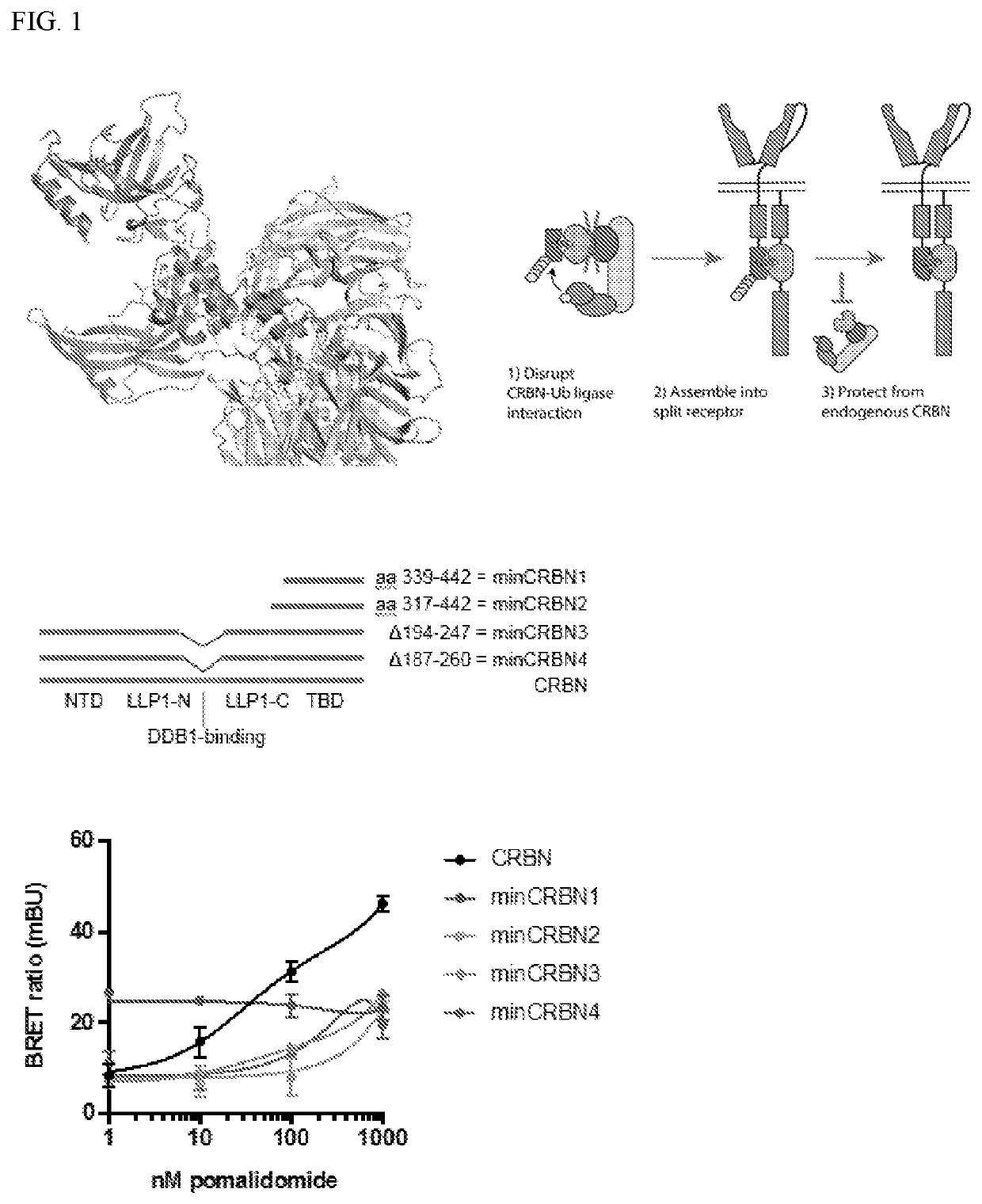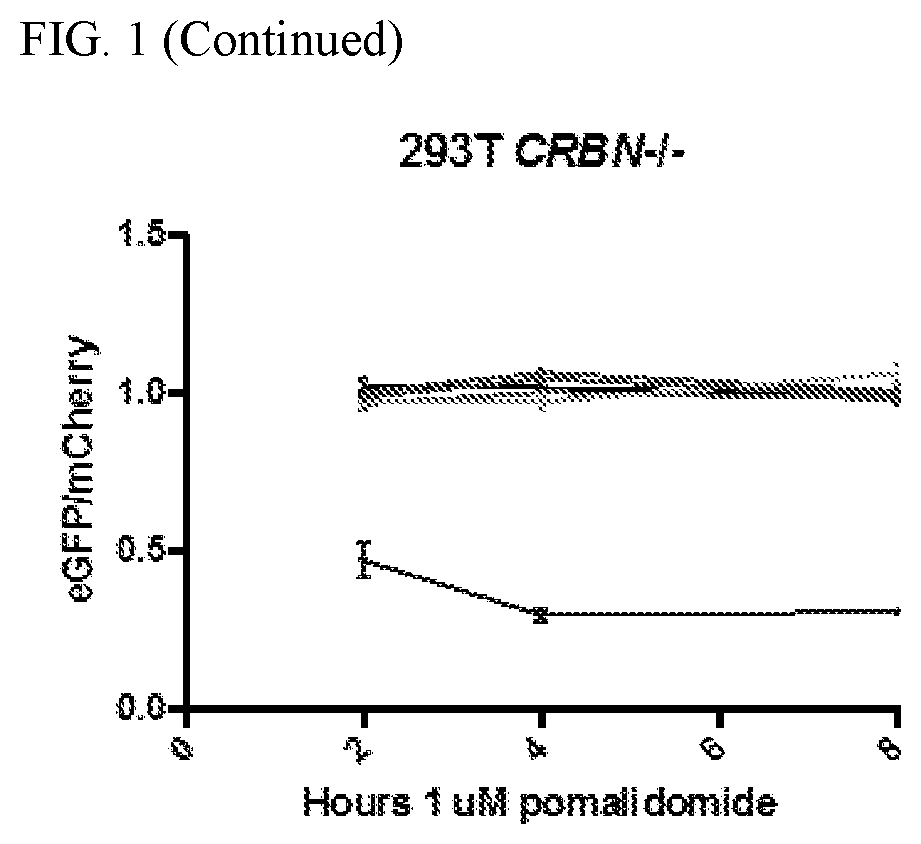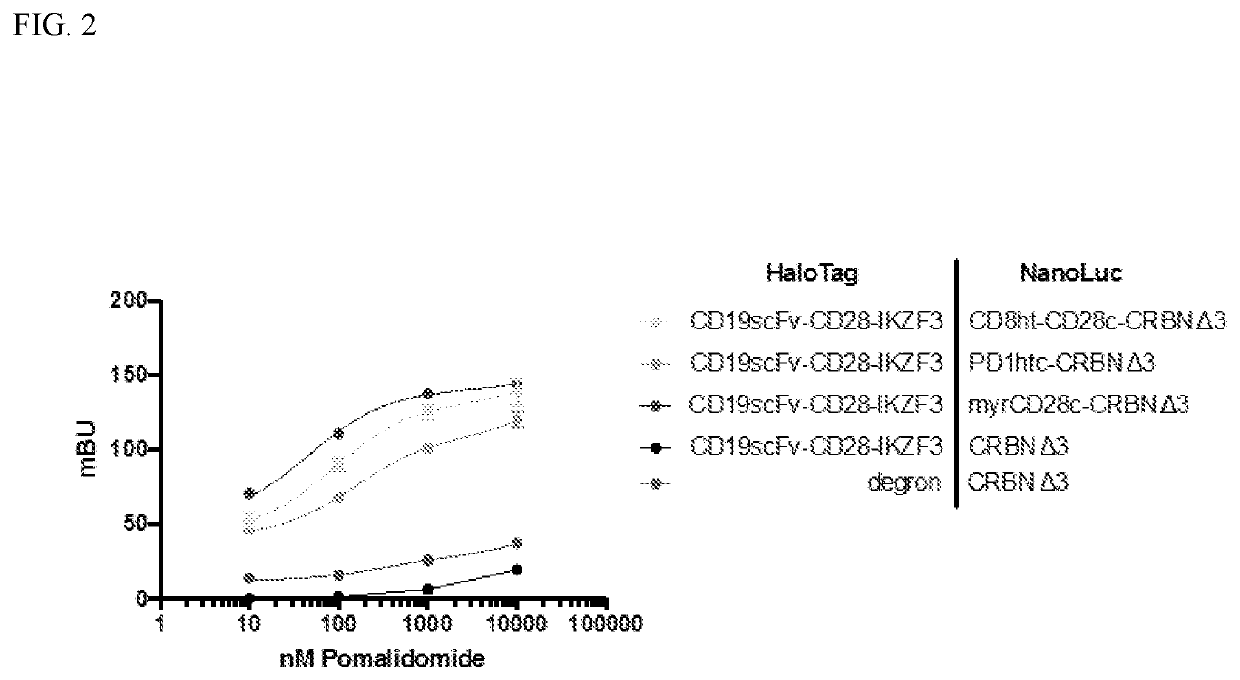Molecular switch-mediated control of engineered cells
a molecular switch and engineered cell technology, applied in the direction of peptides, peptide/protein ingredients, peptide sources, etc., can solve the problems of little can be done (at least with any molecular precision) to stop such a negative reaction, and the user control is not strong enough, so as to reduce or avoid symptoms, signs or causes of the condition, delay or minimize one or more symptoms associated, effect of improving overall therapy
- Summary
- Abstract
- Description
- Claims
- Application Information
AI Technical Summary
Benefits of technology
Problems solved by technology
Method used
Image
Examples
example 1
and Methods
Constructs
[0408]For targeted protein degradation experiments, IKZF3 degron derivatives were synthesized as gene fragments (IDT) and cloned into the Artichoke lentiviral expression marker (pSFFV-insert-linker-eGFP-IRES-mCherry-cppt-EFla-Puro-WPRE; FIG. 9). For BRET dimerization experiments, IKZF3 degron derivatives were cloned into pFC14K (pCMV-insert-HaloTag) and CRBN derivatives were cloned into pFC32K (pCMV-insert-Nanoluciferase) per manufacturer's instructions (Promega™).
Cell Lines
[0409]293T and Jurkat human cell lines were used. 293T cells were maintained in DMEM (Invitrogen) supplemented with 10% FBS, 2 mM L-glutamine, 100 μg / mL penicillin and 100 U / mL streptomycin. Jurkat cells were maintained in RPMI (Invitrogen) supplemented with 10% FBS, 2 mM L-glutamine, 100 μg / mL penicillin and 100 U / mL streptomycin.
Lentivirus Production and Transduction
[0410]Lentiviral packaging was performed by co-transfection of expression, psPAX2, and VSV-G plasmids into 293T cells with Tra...
example 2
Molecular Switch Integration into CAR T Cell Design
[0417]CAR-T cells can act to kill targeted tumor cells, but can also elicit negative effects that are capable of propagating in an unchecked manner. As noted above, conventional CAR-T design uses a single polypeptide that includes tumor antigen-binding domains (e.g., an scFv), a transmembrane domain, a costimulatory domain and a CD3ζ domain (TCR ITAMs), with this single polypeptide therefore capable of both specifically binding a tumor antigen and propagating an activated T cell response. Chimeric antigen receptors (CARs) are recombinant receptor constructs composed of an extracellular single-chain variable fragment (scFv) derived from an antibody, joined to a hinge / spacer peptide and a transmembrane domain, which is further linked to the intracellular T cell signaling domains of the T cell receptor. CAR T cells combine the specificity of an antibody with the cytotoxic and memory functions of T cells. The specific domains of a CAR c...
example 3
y Useful Molecular ON-Switch Design and Implementation
[0418]It was herein contemplated that small molecule gating could enable custom tuning, increased safety and expanded applicability of CAR-T cells, as specifically shown in FIG. 1 for an “ON”-switch applied to CAR-T cells. The exemplified ON-switch CAR of the instant disclosure is a split CAR system that requires small molecule-inducible dimerization of domain A and domain B for activation, which can allow oncologists to tune the activity of CAR-T cells along individualized risk / benefit criteria. Prior to the instant disclosure, while a rapamycin-induced dimerization system had been described (see, e.g., Hubbard et al. Front. Physiol. 5: 478, which shows the structural basis for rapamycin-induced dimerization of FRB and FKBP as the canonical example of chemically-induced dimerization), a clinically valid drug-inducible heterodimerization system had not yet been disclosed.
[0419]In view of the FDA-approved status of thalidomide ana...
PUM
| Property | Measurement | Unit |
|---|---|---|
| Responsivity | aaaaa | aaaaa |
| Degradation properties | aaaaa | aaaaa |
Abstract
Description
Claims
Application Information
 Login to View More
Login to View More - R&D
- Intellectual Property
- Life Sciences
- Materials
- Tech Scout
- Unparalleled Data Quality
- Higher Quality Content
- 60% Fewer Hallucinations
Browse by: Latest US Patents, China's latest patents, Technical Efficacy Thesaurus, Application Domain, Technology Topic, Popular Technical Reports.
© 2025 PatSnap. All rights reserved.Legal|Privacy policy|Modern Slavery Act Transparency Statement|Sitemap|About US| Contact US: help@patsnap.com



